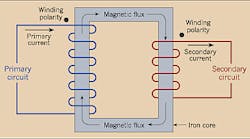How transformers work
A basic transformer consists of two sets of coils or windings. Each set of windings is simply an inductor. AC voltage is applied to one of the windings, called the primary winding. The other winding, called the secondary winding, is positioned in close proximity to the primary winding but is electrically isolated from it.
The alternating current that flows through the primary winding establishes a time-varying magnetic flux, some of which links to the secondary winding and induces a voltage across it. The magnitude of this voltage is proportional to the ratio of the number of turns on the primary winding to the number of turns on the secondary winding. This is known as the “turns ratio.”
To maximize flux linkage with the secondary circuit, an iron core is often used to provide a low-reluctance path for the magnetic flux. The polarity of the windings describes the direction in which the coils were wound onto the core. Polarity determines whether the flux produced by one winding is additive or subtractive with respect to the flux produced by another winding. A basic two-winding transformer is shown in the Figure above.
Three-phase transformers
A basic 3-phase transformer consists of three sets of primary windings, one for each phase, and three sets of secondary windings wound on the same iron core. Separate single-phase transformers can be used and externally interconnected to yield the same results as a 3-phase unit.
The primary windings are connected in one of several ways. The two most common configurations are the delta, in which the polarity end of one winding is connected to the non-polarity end of the next, and the wye, in which all three non-polarity (or polarity) ends are connected together. The secondary windings are connected similarly. This means that a 3-phase transformer can have its primary and secondary windings connected the same (delta-delta or wye-wye), or differently (delta-wye or wye-delta). It's important to remember that the secondary voltage waveforms are in phase with the primary waveforms when the primary and secondary windings are connected the same way. This condition is called “no phase shift.” But when the primary and secondary windings are connected differently, the secondary voltage waveforms will differ from the corresponding primary voltage waveforms by 30 electrical degrees. This is called a 30° phase shift. When two transformers are connected in parallel, their phase shifts must be identical; if not, a short circuit will occur when the transformers are energized.
Autotransformers
An autotransformer is a transformer with an electrical connection between the primary and secondary windings. Autotransformers have considerably more MVA capacity per pound of core iron and winding conductor than standard power transformers but are limited to small turns rations — ideally 2:1.
Although the designs of different transformers vary extensively, their basic operation remains the same.
Special transformers
Transformers can have more than two windings per phase. These designs help reduce fault current levels. Other transformers have been built to operate at relatively low voltages but extremely high currents. Arc furnace transformers fall into this category and can have secondary current ratings in excess of 150,000A. Regulating transformers are designed to maintain their secondary voltage within specific limits as the primary voltage fluctuates. Transformers can also be built to shift phase a specified amount to control the flow of real power in a networked system.




